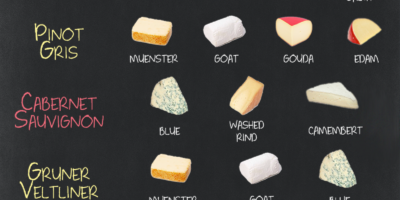Wine and Cheese Pairings
Wine and cheese have a storied history of being enjoyed together. Their flavors can complement and enhance each other. Let’s explore how to create effective and enjoyable wine and cheese pairings.
The Basics of Pairing
Pairing wine and cheese involves understanding the flavor profiles of both. Consider their sweetness, acidity, fat content, and texture. These elements should balance each other out.
For example, a creamy cheese can soften the acidity of a crisp white wine. Similarly, a salty cheese can bring out the sweetness in a dessert wine.
Popular Cheese Types
- Fresh Cheeses: Mozzarella, Ricotta
- Soft-Ripened Cheeses: Brie, Camembert
- Semi-Hard Cheeses: Cheddar, Gouda
- Hard Cheeses: Parmesan, Pecorino
- Blue Cheeses: Gorgonzola, Roquefort
Key Wine Varieties
- White: Chardonnay, Sauvignon Blanc
- Red: Cabernet Sauvignon, Pinot Noir
- Sparkling: Champagne, Prosecco
- Dessert: Port, Sauternes
Classic Pairings
The easiest way to start pairing is by trying out some classic combinations. These have stood the test of time and are widely enjoyed.
Brie and Champagne
Brie is creamy with a mild flavor. Champagne, with its bubbles and high acidity, cuts through the rich texture of Brie. The delicate flavors of both don’t overpower each other, providing a balanced experience.
Cheddar and Cabernet Sauvignon
Cheddar is sharp and robust. It stands up well to the bold flavors of Cabernet Sauvignon. The tannins in the wine match the creaminess of the cheese, while the cheese’s tang complements the wine’s fruitiness.
Goat Cheese and Sauvignon Blanc
Goat cheese is tangy and slightly acidic. Sauvignon Blanc, with its zesty acidity and herbal notes, enhances the cheese’s flavors. This pairing brings out the best in both the wine and the cheese.
Combining Textures
Textures play a big role in pairing. A soft cheese needs a wine that can balance its creaminess, while a hard cheese requires a wine robust enough to match its texture.
Soft Cheeses with Light Wines
Soft cheeses like Camembert need a wine that won’t overshadow them. Try pairing with a light-bodied wine such as Pinot Noir. The wine’s gentle tannins and fruity notes enhance the cheese without overwhelming it.
Hard Cheeses with Full-Bodied Wines
Hard cheeses such as Parmesan have intense flavors. A full-bodied wine like Malbec or Cabernet Sauvignon can provide the necessary balance. These wines have the depth and structure to match the cheese’s firm texture and strong taste.
Exploring Contrasts
Contrasting pairings bring out unique flavors by highlighting differences rather than similarities.
Blue Cheese and Port
Blue cheese is pungent and salty. Pair it with a sweet wine like Port. The sweetness balances the cheese’s saltiness, creating a harmonious taste experience. This contrast also highlights the cheese’s creaminess.
Ricotta and Riesling
Ricotta is mild and slightly sweet. A Riesling, especially one that is off-dry, can emphasize the cheese’s delicate flavors. The wine’s sweetness contrasts with the cheese’s subtle saltiness, enhancing the overall taste.
Regional Pairings
Pairing wines and cheeses from the same region can create a natural harmony. This approach respects the traditional flavors and methods of production.
French Pairings
- Roquefort and Sauternes: Sauternes’ sweetness makes Roquefort’s strong, salty character more approachable.
- Chèvre and Chenin Blanc: The tangy, earthy flavors of Chèvre pair well with the crisp, slightly sweet notes of Chenin Blanc.
Italian Pairings
- Gorgonzola and Moscato d’Asti: Moscato d’Asti’s sweetness contrasts beautifully with the bold, creamy nature of Gorgonzola.
- Parmigiano-Reggiano and Chianti: Chianti’s acidity and tannins complement the nutty, crystalline texture of Parmigiano-Reggiano.
Practical Tips
When planning a wine and cheese party, variety is key. Offer different types of cheeses and a range of wines. This allows guests to find pairings they enjoy and discover new favorites.
Serving Cheese
- Serve cheese at room temperature. This allows their flavors and textures to be fully appreciated.
- Use a separate knife for each cheese to prevent cross-contamination of flavors.
- Arrange cheeses from mildest to strongest on the serving platter.
Serving Wine
- White wines should be served chilled. About 45-50°F (7-10°C) is ideal.
- Red wines are best at slightly below room temperature. Aim for 60-65°F (15-18°C).
- Sparkling wines should be well-chilled. Serve them around 40-45°F (4-7°C).
Experiment and Enjoy
Don’t be afraid to experiment. Personal taste plays a big role in what combinations work best. Some people might prefer a pairing that others don’t. The key is to have fun and enjoy the process.
“`
Quality wine glasses make a difference in the tasting experience.

